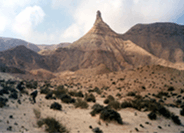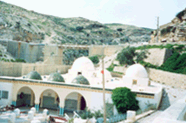|
Metalogenic overview
Tunisia is essentially a sedimentary country. The stratigraphic series are spread from the primary until the quaternary ages. The emergence of magmatic rocks of the Miocene age is well known in the extreme northern region of the country.
The metallogenic of Tunisia is intimately related to the structural zonation. Indeed, the mineral indications that are listed in all the territories show a reparation that according to the geotectonic entity. Hence, the following zonation was distinguished :
-
The Tellian Atlas or formation zones (I)
The mineralizations that are associated to this zone are of a polymetalic nature, from which we encounter.
- The associations Cu, W, Sn, Pb, ZN, Fe in the platform domain.
- The associations Fe, Cu, Ag, Au, As, Pb, Zn, which are related to the Neogene volcanism of Nefza-Sejnan.
- The associations Hg, Pb, Zn, Cu, As, Sb, Au, at the level of profound injected accidents.
- The association Pb-ZN in the basins of detrital filling.
-
The Atlas group: (II, III, IV, VI)
This domain is composed of 4 zones :
- The Diapirs zone, also known as Domes (II) :
have been associated with diapirs of a Triassic age, several deposits, mining deposits and indices particularly to: Pb-Zn, as well as Sr, Ba and Fe.
- The carbonated Platform of Tunisia’s Center regions (III) :
the mineralizations of Pb, Zn, Ba and Fe are associated with the big cretaceous.
- The North-south axis (IV) :
the mineralizations of Fe, Ba, Zn, and Pb are related especially to the Jurassic-cretaceous unconformity. This is exactly the case of the fluoridated province in Zaghouan.
- Gafsa’s basin (VI) :
It is well known by its numerous phosphate deposits and its reserve in oolitic iron.
-
The Oriental platform (V)
The Miocene series are reach in brown coal stratums. Disulphide of plumb and Zinc are indicated in certain petroleum drillings.
-
The Saharan platform (VII)
During this coverage, some deposits of manganese, iron, Pb-, Zn, and Celestine were only indicated.
|

Tunisia: a sedimentary country

A panoramic view of Jbel-slata diapir in the Diapir zone-Tajerouine region

A massive mineralization of Zinc situated in contact between a Triassic diapir and the cretaceous cover at the level Fej-Lahdoum mine.

A massive mineralization of fluorite and Barytine situated at Hammam Zriba mine in Zaghouan

The big geotectonic entities of Tunisia
(Larger image - click here)
|



